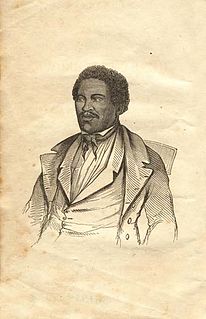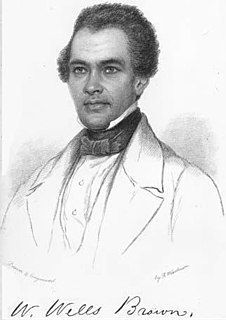
Slavery in the colonial area which later became the United States (1600–1776) developed from complex factors, and researchers have proposed several theories to explain the development of the institution of slavery and of the slave trade. Slavery strongly correlated with Europe's American colonies' need for labor, especially for the labor-intensive plantation economies of the sugar colonies in the Caribbean, operated by Great Britain, France, Spain, and the Dutch Republic.

Ted Healy was an American vaudeville performer, comedian, and actor. Though he is chiefly remembered as the creator of the Three Stooges and the style of slapstick comedy that they later made famous, he had a successful stage and film career of his own, and was cited as a formative influence by several later comedy stars. His sister Marcia Healy costarred with the Three Stooges in The Sitter Downers.

Henry "Box" Brown was a 19th-century Virginia slave who escaped to freedom at the age of 33 by arranging to have himself mailed in a wooden crate in 1849 to abolitionists in Philadelphia, Pennsylvania.

Martha Skelton Jefferson was the wife of Thomas Jefferson. It was her second marriage. She served as First Lady of Virginia during Thomas' term as Governor from 1779 to 1781. She died in 1782, nineteen years before he was elected President, and forty-three before his passing.

Sterling Allen Brown was a black professor, folklorist, poet, literary critic, and first Poet Laureate of the District of Columbia. He chiefly studied black culture of the Southern United States and was a full professor at Howard University for most of his career. He was a visiting professor at several other notable institutions, including Vassar College, New York University (NYU), Atlanta University, and Yale University.

John Brown, also known by his slave name, "Fed", was born into slavery on a plantation in Southampton County, Virginia. He is known for his memoir published in London, England in 1855, Slave Life in Georgia: A Narrative of the Life, Sufferings, and Escape of John Brown, a Fugitive Slave, Now in England. This slave narrative, dictated to a helper who wrote it, recounted his life and later escape from slavery in Georgia. He lived in London from 1850 to the end of his life, marrying an English woman.

James Augustine Healy was an American Roman Catholic priest and the second bishop of Portland, Maine; he was the first bishop in the United States of any known African descent. Born in Georgia to a mixed-race slave mother and Irish immigrant father, he identified and was accepted as white Irish American, as he was half Irish and majority European ancestry. When he was ordained in 1854, his mixed-race ancestry was not widely known outside his mentors in the Catholic Church.

Patrick Francis Healy was a Jesuit priest, educator, and the 29th President of Georgetown University (1874–1882), known for expanding the school following the American Civil War. Healy Hall was constructed during Healy's tenure and is named after him. It was designated as a National Historic Landmark in the late 20th century.

William Wells Brown was a prominent African-American abolitionist lecturer, novelist, playwright, and historian in the United States. Born into slavery in Montgomery County, Kentucky, near the town of Mount Sterling, Brown escaped to Ohio in 1834 at the age of 20. He settled in Boston, Massachusetts, where he worked for abolitionist causes and became a prolific writer. While working for abolition, Brown also supported causes including: temperance, women's suffrage, pacifism, prison reform, and an anti-tobacco movement. His novel Clotel (1853), considered the first novel written by an African American, was published in London, England, where he resided at the time; it was later published in the United States.

A house slave was a slave who worked, and often lived, in the house of the slave-owner. House slaves had many duties such as cooking, cleaning, serving meals, and caring for children.

Michael Augustine Healy was a career officer with the United States Revenue Cutter Service, reaching the rank of captain. He commanded several vessels within the territory of the Alaskan coastline.

The John Brown Farm State Historic Site includes the home and final resting place of abolitionist John Brown (1800-1859). It is located on John Brown Road in North Elba near Lake Placid, New York, where John Brown moved in 1849 to lead freed slaves in farming. It was declared a National Historic Landmark in 1998. It has been managed by the state since 1896; the grounds are open to the public on a year-round basis, and tours of the house are offered in the warmer months.
Elizabeth "Betty" Hemings was an enslaved mixed-race woman in colonial Virginia. With her master, planter John Wayles, she had six children, including Sally Hemings. These children were three-quarters white, and, following the condition of their mother, they were enslaved from birth; they were half-siblings to Wayles's daughter, Martha Jefferson. After Wayles died, the Hemings family and some 120 other slaves were inherited, along with 11,000 acres and £4,000 debt, as part of his estate by his daughter Martha and her husband Thomas Jefferson.
The Healy family of Georgia became notable in U.S. history because of the high achievements of its first generation of children, who were born into slavery in Georgia in the second half of the nineteenth century. Most became prominent as leaders within the Catholic Church. They were mixed-race children of Mary Eliza Smith, a mulatto slave, and her common-law husband, Michael Morris Healy, an Irish Catholic immigrant from County Roscommon. He became a wealthy cotton planter in Jones County. Georgia prohibited slaves from being educated. As Healy was determined to provide a future for his children, he sent them North for their educations, as did some other wealthy planters with mixed-race children. Majority white in ancestry, the children varied in appearance. They were baptized and educated as Catholic in the North, and gained opportunities as Irish Catholics. Most of the sons first attended Quaker boarding schools in New York and New Jersey before transferring to a Catholic school in Massachusetts. All but the fifth son graduated from college. James, Patrick and Sherwood Healy all undertook graduate studies at the Saint Sulpice Seminary in Paris, and the latter two earned doctorates there. The three daughters were educated at long-established Catholic convent schools in Montreal, Quebec, Canada.

The Chicago Colleens were a women's professional baseball team who played in the All-American Girls Professional Baseball League. The team represented Chicago, Illinois and played their home games at Shewbridge Field at the corner of South Morgan and West 74th Streets on the South Side of Chicago, now part of the campus of the Stagg School of Excellence.

Zis Boom Bah is a 1941 American film directed by William Nigh. The film is also known as College Sweethearts.

Fountain Hughes was born a slave in Charlottesville, Virginia in the United States and freed in 1865 after the American Civil War. He worked as a laborer for most of his life, moving in 1881 from Virginia to Baltimore, Maryland. He was interviewed in June 1949 about his life by the Library of Congress as part of the Federal Writers' Project of former slaves' oral histories. The recorded interview is online through the Library of Congress and the World Digital Library.
Thomas Gerard Healy, was a political activist, a co-founder of the International Committee of the Fourth International and the leader of the Socialist Labour League and later the Workers Revolutionary Party. The part of the Trotskyist movement associated with Healy between 1950 and 1985 was at times the largest in Great Britain.
The Irresistible Lover is a lost 1927 American silent comedy film directed by William Beaudine.
George DeBaptiste was a prominent African-American conductor on the Underground Railroad in southern Indiana and Detroit, Michigan. Born free in Virginia, he moved as a young man to the free state of Indiana. In 1840, he served as valet and then White House steward for US President William Henry Harrison, who was from that state. In the 1830s and 1840s DeBaptiste was an active conductor in Madison, Indiana. Located along the Ohio River across from Kentucky, a slave state, this town was a destination for refugee slaves seeking escape from slavery.














